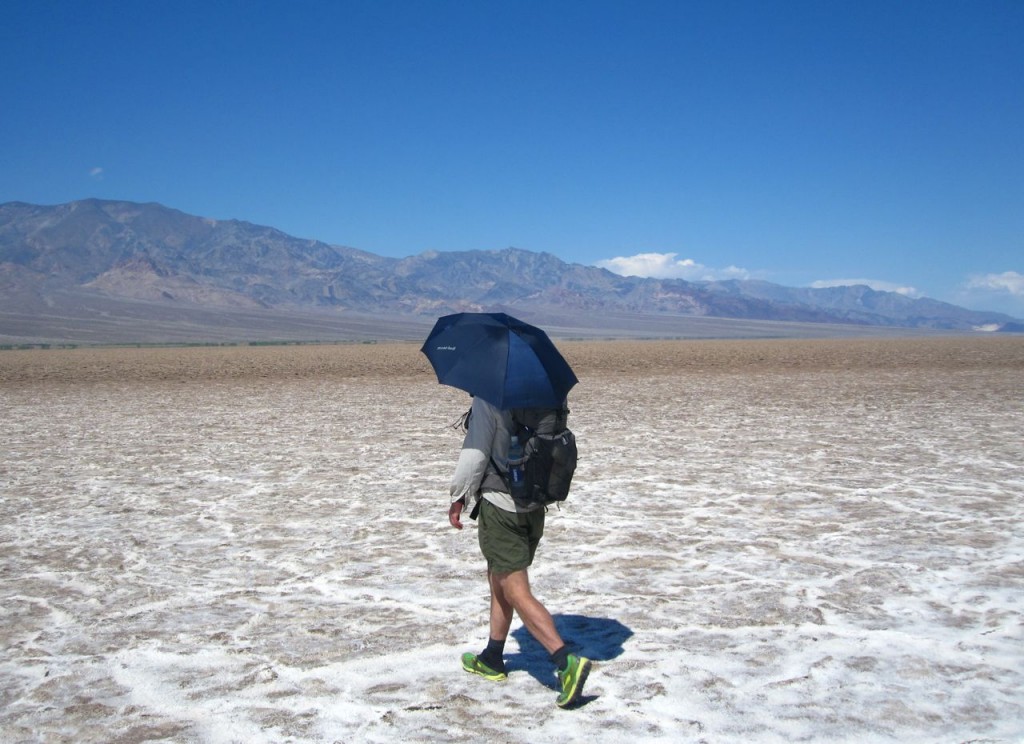Umbrella
Umbrellas offer an unbeatable combination of shade and ventilation. However, unless you’re in the mood to channel your inner-Mary Poppins, you may want to leave them at home when hiking in exposed areas prone to driving wind and rain. Also not great when hiking off-trail in overgrown terrain.
I use an umbrella in the following conditions:
- In extremely hot (35°C/95° F), shadeless environments. In such situations, the weight penalty of carrying an umbrella is more than offset by the need to haul less water, due to the fact that you have created your own little shady microclimate.
- When journeying in thickly wooded forests in cool and wet conditions. Indeed, whilst hiking in freezing rain, I have found an umbrella to be worth its weight in gold in helping to keep my core temperature regular. For example, during my late Fall/early winter hike of the Appalachian Trail in 2012, an umbrella helped to keep my torso warm and dry despite constant precipitation and temps that rarely got above 5°c (41°F).
Gaiters
In snowbound terrain and thick mud, I use MLD eVent gaiters which are lightweight, breathable and stop the snow and mud from entering in the tops of my shoes.
In dry, arid terrain I will usually wear ankle-high Dirty Girl gaiters to keep out dirt and debris.
When hiking through overgrown terrain in very warm temperatures, rather than using knee-high gaiters I will sometimes combine Dirty Girl gaiters with a couple of bandanas tied around my lower legs; does the same job without the sweaty, clammy feeling of longer gaiters.
Utility Tool
Keep it simple. A small multi-tool that has a knife, tweezers, and scissors should be sufficient. The Victorinox Swiss Army Classic has been my choice for more than a decade. It weighs in at just over an ounce.
Note that tweezers are essential when hiking in tick-infested areas and scissors are great for repairs and keeping your toenails trimmed.
Water Containers
I usually carry a combination of plastic soda/sports drink bottles (600 ml each) and collapsible Platypus bladders.
These containers are much lighter than their polycarbonate or polyethylene (i.e. hard plastic) equivalents.
On all multi-day backpacking trips, I will carry two soda bottles (one for each side pocket of my pack), whilst the quantity and capacity of the Platypus bladders will depend upon the environmental conditions and regularity of water sources.
Hiking Poles
I have tried hiking with poles a handful of times. I find that if am carrying a heavy load, they can be useful in taking some of the strain off my knees during particularly steep descents. However, for walking on the flat or uphills I find them to be more of a hindrance than a help. Even more so on technical, off-trail terrain when I am focusing on foot placement……..why would I want to be worried about pole placement as well?
These days I occasionally carry one pole; not for hiking, but as a means of support for my shelter (e.g. tarp or single wall silnylon tent) and occasionally to act as a “third leg” during challenging river crossings. Whilst they have never been my cup of tea, I have quite a few hiker buddies that wouldn’t hike without them. At the end of the day, it’s a personal choice. For hikers with a history of knee problems, they can be a good option. Click here for an overview of the pros and cons of hiking with poles.



